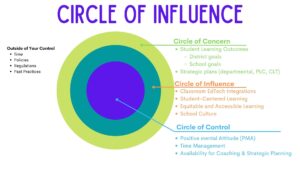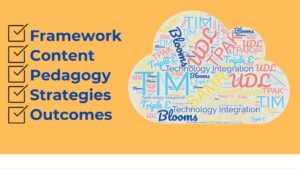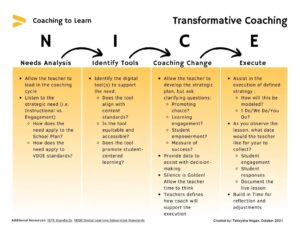My experience with change management comes from a few different industries. For the last six years I have been in education, but prior to that I was in the consumer finance and insurance industries where I found myself constantly surrounded by emerging technology and continuous change. One thing that I have learned to embrace over time is change. Specifically focusing on the things that I am able to influence, and those things that are within my control. I’ve found that investing time an energy, time, and interest into things that you can’t control, leads to burnout, stress, and decreased morale. In this article, we will explore the process of managing change within the context of EdTech.
Walt Disney once said, “Times and conditions change so rapidly that we must keep our aim focused on the future”. A critical component of being a change agent is being forward-thinking and having a growth mindset, focusing on the goal and outcome. Another of Disney’s famous quotes says, “Of all of the things that I’ve done, the most vital is coordinating those who work with me and aiming their efforts at a certain goal”. No one can effect change by themselves, it takes collaboration, knowing your strengths and weaknesses, working together to achieve a common goal, and cultivating and maintaining relationships with those whom you desire to effect change.
Consider the first several weeks of school, educators are building relationships, establishing norms, and learning about each learner’s preferred method of receiving feedback and learning style. These same concepts should be taken into consideration when managing change with adult learners, as these factors don’t just disappear once a K-12 student graduates and/or enters adulthood.
Knowing what is within our sphere of influence and control is another important element of managing change. I was first introduced to the circle of influence after reading Steven Covey’s, The 7 Habits of Highly Effective People. The circle of influence has really stuck with me as it helped me understand and accept what I was able to influence and what I had control over as a change agent, and not worrying about those things that were outside of my control.
As a change agent, the circle of concern are all the things that you are aware of and are concerned about (i.e. district goals, school goals, strategic planning, etc.). The circle of influence is a collaborative area where you play a part in the outcome (i.e. school culture, student centered learning, equitable and accessible learning, classroom EdTech integrations, etc.). The circle of control is a very powerful place, because it is all YOU. Within the circle of control are all the things that you have the individual ownership and ability of managing and changing (i.e. PMA: Positive Mental Attitude, time management, availability for coaching and strategic planning).

During my interview with Prince William County Public Schools, I was asked to pick a topic that I would present on for five minutes. As you probably guessed, my presentation was on the importance of managing change. I’ve revisited that presentation several times over the past six years, but what I’ve realized is regardless of the industry, managing change can be summarized by a few key components:
- Focus on the Outcomes – you are providing a solution to a need or problem.
- Be open to feedback – always maintain professionalism and work collaboratively to identify the need.
- Actively Listen – Use the 80/20 rule (listen 80 percent of the time and speak the other 20 percent), take notes, keep a “parking lot” for any unanswered questions/inquiries.
- Offer Equitable Solutions – provide solutions that offer choice, equity and accessibility, and differentiation.
- Prepare & Execute – develop the plan, what implementation/technology framework will be used, key performance indicators, measures of success, and executive of the plan.
- Have a Follow Up Plan – schedule time for reflection and adjustments.
Understanding what is within your circle of influence and control, fused with these change management components, creates a solution-oriented work team that feels vested in the change management process, and from what I have experienced first-hand, increases engagement and synergy while achieving efficient and effective solutions.
Managing change within the context of EdTech integrations, requires change agents to have a plan of implementation. For this, change agents utilize one or many of the research-based technology integration frameworks that exist. Some frameworks are widely adopted, while others are used by small groups. In either case, change agents should utilize a framework that most effectively meets the needs of the educator and learners. Regardless of the technology integration framework selected, it should always be utilized within the context of the content, pedagogy, learning outcomes and strategies. Remember, the technology exists to support instruction, not replace it.

Based on my experience as a change agent along with the different components of change management, coaching, and frameworks in EdTech, I developed the NICE Transformative Coaching© model. This model provides a flexible change management strategy that puts educators in the driver’s seat and gives them an active voice throughout the coaching cycle to determine the most effectives tools and strategies for their learners. The NICE Transformative Coaching model is defined by four main areas:
- Needs Analysis – this is the initial phase of the coaching cycle; educators are encouraged to take the lead. In this phase, the change agent (coach/trainer), is actively listening to identify the need(s).
- Identify Tools – once the need(s) have been defined, the change agent will share the EdTech tools that are available that may support the need.
- Coaching Change – during the coaching phase, educators will develop the plan for integrating the EdTech into their classroom. The change agent should ask clarifying questions, provide data on the tool, and share various frameworks. It is important during this phase that change agents allow the educator to process the information. This may mean a series of follow up coaching sessions as needed while the educator develops or revisits their lesson plans. At the end of the coaching phase, the educator should define if the change agent will be needed to support the execution of the plan, and how the change agent will support.
- Execute – after the plan has been established, the strategy or plan will be executed. At the end of this phase, there should be time designated for reflections and adjustments; thereby either restarting the coaching cycle.

Change is not always easy, but it is inevitable. Having the right mindset and strategies in place and being consistent in those areas, equips educators with the tools needed to focus on solutions, take risks, and innovate; thereby creating a culture that promotes student-centered authentic, equitable, accessible, and engaging learning experiences for students.
References
Covey, S. (1989). The 7 habits of highly effective people: Restoring the character ethic . New York: Simon and Schuster.
Digital Learning Integration Standards of Learning. (2021, October 29). Retrieved from Virginia Department of Education: https://www.doe.virginia.gov/support/technology/standards/index.shtml
The ISTE Standards. (2021, October 29). Retrieved from ISTE: https://www.iste.org/iste-standards
Technology Resources
All graphics were designed utilizing Canva. The word cloud within the technology integration framework graphic was created using WordClouds.com
Written by Takeysha Hogan. Takeysha is a senior training specialist in the Department of Information and Instructional Technology for Prince William County Schools in Northern Virginia. Based on her experiences working in the private sector as well as public education, Takeysha developed a passion for change management, and learning and instructional strategies that promote synergy and community in the workplace and classroom to enhance the learning experiencing for all student and adult learners. For more information, follow her on LinkedIn and Twitter @takeyshahogan



